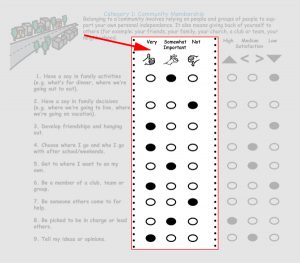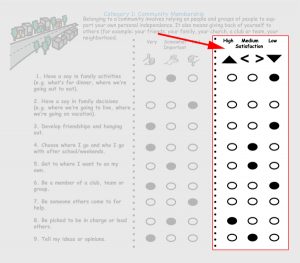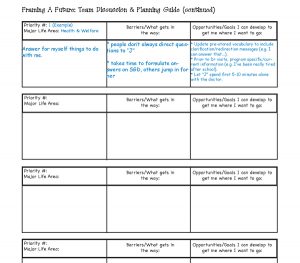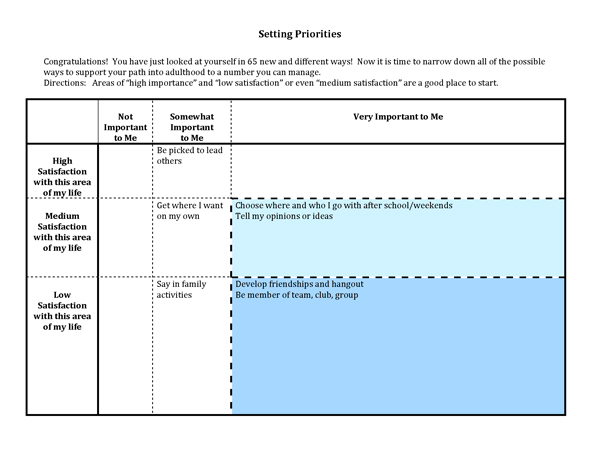In order to assist students/young adults in identifying those things that are personally important to them, we begin with a self-discovery survey of 65 items. It is critical that the young adults participate in this self-discovery survey and subsequent planning. They should be the informants during the process rather than a parent or caregiver as there may be conflicting priorities. There are times however when the young adult may need assistance from a parent/caregiver to participate in this survey.
Step 1. Establish sufficient context and background knowledge of the tool and of the student.
It is critical that the person administering this survey be familiar with the tool and with the student. Being aware of the language used in the survey helps the administrator evaluate the appropriateness of the terminology and the concepts as they relate to the student’s understanding. Familiarity with the student will assist them in using examples from the student’s life experiences to illustrate the concepts in the tool. It may be necessary to develop a unit of study or curriculum introducing the various concepts and vocabulary in the survey prior to its administration. This will ensure that the student has a clear understanding and that the content is personalized and relevant to each student.
FAF Background Survey [53KB, PDF]
Taken from: Steps to Self-Determination: A Curriculum to Help Adolescents Learn to Achieve their Goals, 2nd Edition. S. Field & A. Hoffman.
Step 2. Ensure full access in terms of concepts and response formats.
It is important to remember that FAF is an interactive process and that the survey is just the tool used to focus attention and gain feedback on specifically determined areas. Unless the student is familiar with the concepts presented and has a viable method of communicating his/her response, the information gathered is of questionable value. There are some important considerations in this interactive process:
- Ensure that the person administering the survey has read through the entire tool and fully understands the purpose, process and application of results.
- Ensure that the complexity of the language used is at the appropriate level for the student.
- Provide the student with definitions and examples of terminology used in the tool.
- Consider the length of time the student can remain focused on a given task as well as the number of items they can meaningfully respond to in a given time period. Successful implementation of FAF may need to occur over multiple sessions.
- Determine how the survey items on the tool will be presented to the student as well as the method the student will be using to respond. These methods can vary widely and are based on individual student needs. For example:
- some students complete the survey independently on the computer or in paper format
- some students are provided a modified version of the survey with a reduced number of items, reduced complexity of language and a response format of two contrasting choices
- some students utilize alternative access to complete the survey (e.g., adapted keyboard and overlay, auditory/visual scanning and switches, speech-generating device, etc.)
Step 3. Application of tool.

The first stage assists the students in determining what is important to them. This is accomplished by presenting to the student a series of benchmarks in each of the seven major life areas and the student indicating the level of importance of each: Very Important, Somewhat Important, Not Important. This may take multiple sessions based on the stamina and persistence of the student.

Once the young adult rates how important items are in a particular life area, the second stage is for him/her to evaluate those benchmarks in terms of their current satisfaction with this part of their life. The young adult rates how satisfied they are with the items they indicated were very or somewhat important to them. This helps to answer the question of whether or not any action needs to take place to improve their level of satisfaction in a particular area. If the young adult has difficulty responding to this section of the tool regarding satisfaction, the team can still utilize the information regarding level of importance, with individual items, to inform the planning process.

The third stage in the application of the tool is to establish critical priorities in areas in which the student has expressed an interest in developing more skill and confidence. Completing the FAF survey is only a part of the whole process. Plugging their information into a matrix allows the young adult to clearly see those items that are of higher priority (e.g. those items that fall into the category(ies) of “very important to me” – “low satisfaction with this area of my life”).
In order to complete the matrix, look back at all the items that were determined to be Very or Somewhat Important. Then for each of those benchmarks look at how the individual rated the level of satisfaction for that item. Write that item in the corresponding box in the matrix. The sample matrix below summarizes the information gathered in the survey shown above. By plugging this information into the matrix, you can see that two items clearly stand out as things that are very important to the individual but are also areas they have low satisfaction with in their life.

The fourth stage in the application of the tool is determining what steps need to be taken to address these priorities. After the young adult completes the Importance and Satisfaction (if appropriate) sections of FAF, providing an opportunity for them to share their results with their family and other team members is critical. It is crucial that the young adult be an active member during the planning and discussion by having the young adult review their responses, and participate in the decision making regarding how to present this information to their family and team. By taking the time to work with the young adult to decide what information they would like to share and how it will be shared with others prepares the individual to not only be a participant in their life planning process but also empowers them to lead this process.
The Discussion and Planning Guide provides a format for this action planning process.
Step 4. Incorporating the results into the formal future planning process.
The final step in the FAF process is, perhaps, the most critical. Once the information has been gathered, the priorities established, the barriers identified and the goals and objectives developed, this collective data must make its way into a formal planning document such as an Individual Transition Plan (ITP) or a Person-Centered Transition Plan.
As with any plan, unless there are positive steps to ensure that the goals and objectives are actually addressed in the educational program for the student, the process becomes simply an exercise without making any significant changes for the student. Used effectively, however, the results of this FAF process can positively impact the quality of life for individuals who use augmentative and alternative communication. Ideally, the results of FAF would be presented to the transition planning team by the student and/or a family member. The transition planning team would incorporate the data into the formal planning process, provide the appropriate supports and resources and oversee the implementation of the goals and objectives.

